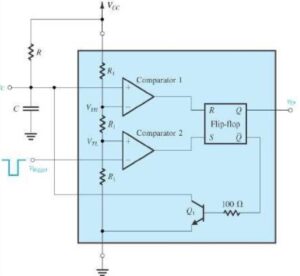Linear Integrated Circuit: Experiment No: 5 To build Operational Amplifier as Voltage Regulator using IC 723.
Object: To build Operational Amplifier as Voltage Regulator using IC 723.
Apparatus Required: Bread Board, 723 IC, ±12V supply, Resistors, Capacitor and connecting leads.
Theory: A voltage regulator is an integrated circuit (IC) that provides a constant fixed output voltage regardless of a change in the load or input voltage. A linear voltage regulator works by automatically adjusting the resistance via a feedback loop, accounting for changes in both load and input, all while keeping the output voltage constant.
The IC723 is a general purpose regulator which can be adjusted over a wide range of both +ve or –ve regulated voltage. This is a 14-pin DIP package. . This IC is inherently low current device but can be boosted to provide 5 amps or more current by connecting external components. The limitation of 723 is that it has no in-built thermal protection. It also has no short-circuit current limits. The IC723 has two sections. The first section consists of Zener Diode constant current source and a reference amplifier. The other section of the IC consists of an error amplifier series pass transistor and a current limit transistor. This is a 14-pin DIP package. The main features of 723 include an input voltage of 40v max, output voltage is adjustable from 2V to 37V, 150mA output current without external pass resistor, can be used as either a linear or a switching regulator.

Observation Table:

Advantages Of Voltage Regulator
- It is very simple to implement and easy to use.
- It gives low output ripple voltage.
- It has a fast response time to load.
- It has less noise and low electromagnetic interference.
- It is more cost-efficient.
Disadvantages Of Voltage Regulator
- Its efficiency of it is relatively low.
- It gives the output voltage always less than the input voltage i.e., it performs only step down operation.
- It requires a heat sink since it dissipates excess power as heat and becomes extremely hot during regulation.
- It requires large spaces.
Applications Of Voltage Regulator
- One of the most common examples is the mobile charger. The adapter is supplied with an AC signal. However, the output voltage signal is a regulated DC signal.
- Every power supply in the world uses a voltage regulator to provide the desired output voltage. Computers, televisions, laptops, and all sorts of devices are powered using this concept.
- Small electronic circuits rely on regulators to operate. Even the slightest fluctuation in voltage signal can damage the components of a circuit such as ICs.
- When it comes to power generation systems, voltage regulators play an essential part in their operation. A solar power plant generates electricity based on the intensity of sunlight. It needs a regulator to ensure a regulated constant output signal.
PRECAUTIONS:
- Check the circuit connections before switching on the power supply.
- Check the connections between pin no.2 and ground.
- Check the continuity of the connecting wires.
Result: The constant output voltage is observed using the circuit.





